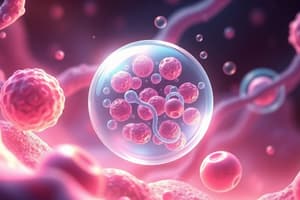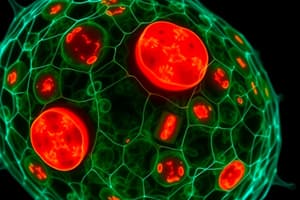Podcast
Questions and Answers
Which organelle is responsible for digesting non-usable materials within the cell?
Which organelle is responsible for digesting non-usable materials within the cell?
- Lysosomes (correct)
- Mitochondria
- Nucleus
- Peroxisomes
What is the main function of peroxisomes in the cell?
What is the main function of peroxisomes in the cell?
- Store genetic material
- Detoxify harmful substances (correct)
- Digest proteins
- Produce ATP from food
What role do mitochondria play in cellular metabolism?
What role do mitochondria play in cellular metabolism?
- Provide ATP for cellular energy (correct)
- Store nutrients
- Produce ribosomes
- Regulate gene expression
Which part of the cell provides structural support and shape?
Which part of the cell provides structural support and shape?
What describes the structure of the nuclear membrane?
What describes the structure of the nuclear membrane?
What is the function of nucleoli within the nucleus?
What is the function of nucleoli within the nucleus?
Which component of the nucleus contains the genetic material?
Which component of the nucleus contains the genetic material?
What type of cell lacks a membrane-bound nucleus?
What type of cell lacks a membrane-bound nucleus?
What is the typical size range for eukaryotic cells?
What is the typical size range for eukaryotic cells?
What structure is formed by the condensation of chromatin during cell division?
What structure is formed by the condensation of chromatin during cell division?
Flashcards are hidden until you start studying
Study Notes
Lysosomes
- Contain digestive enzymes for breaking down non-usable cellular materials.
Peroxisomes
- Membrane-bound sacs filled with oxidase enzymes.
- Detoxify harmful substances and break down free radicals.
- Replicate by reproducing through binary fission (pinching in half).
Mitochondria
- Known as the "powerhouses" of the cell due to ATP production.
- Continuously change shape.
- Conduct aerobic reactions, using oxygen to convert food into energy.
Cytoskeleton
- Composed of a network of protein structures within the cytoplasm.
- Provides internal support and shape to the cell.
- Consists of three types of filaments:
- Microfilaments (actin): approximately 2 nm diameter.
- Intermediate filaments: approximately 10 nm diameter.
- Microtubules (tubulin): approximately 25 nm diameter.
Centrioles
- Rod-shaped structures made up of microtubules.
- Play a critical role in forming the mitotic spindle during cell division.
Nucleus
- Acts as the control center of the cell, housing genetic material (DNA).
- Composed of three main regions:
- Nuclear membrane: a double-layered phospholipid barrier with nuclear pores.
- Nucleolus: site of ribosome production.
- Nucleoplasm: gel-like substance containing chromatin within the nucleus.
Nuclear Membrane
- Double phospholipid membrane acting as a barrier for the nucleus.
- Contains nuclear pores facilitating material exchange with the cytoplasm.
Nucleoli
- One or more nucleoli are present within the nucleus.
- Responsible for synthesizing ribosomes, which migrate to the cytoplasm through nuclear pores.
Nucleoplasm
- The semi-fluid matrix inside the nucleus, analogous to cytoplasm.
- Contains chromatin, which is a combination of DNA and histone proteins.
Chromatin
- Made of DNA and proteins, dispersed throughout the nucleus.
- Condenses into chromosomes during cell division.
Prokaryote vs. Eukaryote
-
Prokaryote:
- Unicellular organisms without a membrane-bound nucleus; genetic material is located in the nucleoid.
- Typically smaller in size (1-5 microns) with single, circular DNA.
-
Eukaryote:
- Unicellular or multicellular organisms with a membrane-bound nucleus containing linear, multiple copies of DNA.
- Generally larger in size (10-100 microns).
Studying That Suits You
Use AI to generate personalized quizzes and flashcards to suit your learning preferences.




